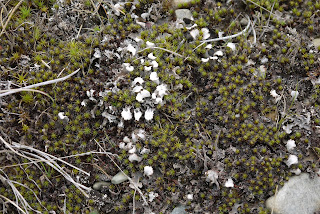I think about vision more than I used to now that my once
keen eyesight has more than lost its edge in middle age. Romantic era poet Samuel Taylor
Coleridge spoke frequently of the tyranny or "despotism" of the eye
and how the sense of sight dominates us. Coleridge was right, and even so, it
is sobering to realize just how sight-dominated many people are. They often value such limited types of
sights that they don't really see what the world has to offer. My own ever-dimming yet still dominant sense
of sight prompts me to reflect upon Americans’ oft-declared desire to travel
and experience the outdoors.
People expect a lot out of their road trips, vacations, and nature
in general, and if nature doesn’t put out they are annoyed. They want non-stop
adventure, grand vistas, huge spectacles, and large wild animals. Last year I
set up my spotting scope on a marshy lakeside in Yellowstone National Park.
There were at least 15 different species of ducks, grebes, herons, cranes, and
geese feeding, sleeping, shepherding babies, and otherwise thriving in the
protected park environment. I hadn't been there two minutes before several
campers and motor homes rattled up behind me. "See any bears?" was
the collective query. I replied in the negative and started to list the birds
they could see, but before the third species I heard the camper doors slam and
engines start.
The little stuff just doesn’t attract so many folks. On days
when it rains or snows in the Tetons, Yellowstone, Yosemite, or Glacier – any national
park or “destination” site, really -- a chorus of agonized cries about ruined
vacations echoes through the nation. The
Going-to-the-Sun road in Glacier is often still closed in July, but people act
as if Nature screwed up and didn’t deliver the goods. However, if you simply look down instead of
up (where those horrid clouds are) the world is still full of wonders.
Look right between
your feet at the ground. Notice the variety of plant life and the types of soil
and rock around you. If it has been raining, you are in for a treat. Rain intensifies
hues, and the overcast sky shields small rocks and plants from the sun and its
tendency to wash out color. Look at
this salamander, fresh and green in the rain.
What if the same bird lives at home and also in faraway
places on a road trip? Many people are bored, and demand that nature be more
attentive to their need for new and entertaining sights. Once again, much is
missed in adopting this attitude. I have renewed respect for a bird I have seen
all my life: the robin. This creature can live anywhere from arid desert to cherry
orchard to damp rain forest. Noticing the ubiquitous robin can also teach you
about the endless changes in landscape across this country and the conditions
under which the robin must feed, find nesting materials, and raise young.
The ruffed grouse, too, is a bird that I have seen so many
times in Minnesota and is also in high
mountainous Montana country.
Then there is the spruce grouse. I had never seen one before
I visited the Yaak valley. Apparently, many people, including avid birders,
literally overlook this bird not only because they do not look down but because
they look for the bright moving target rather than the quiet motionless one.
Here is a female that I saw ambling slowly through the grasses and flowers by
the side of a dirt road high in the Yaak.
The male had discovered her, too. Here he is, in full
courtship display in the bend of the road near the female. Not at all perturbed
by us or the idling car, he ran hither and yon and never deflated. On our way
back down the mountain an hour and a half later he was still there.
One of the best ways to truly see the outdoors is to put
away the camera. I enjoy taking pictures, but I agree with Barry Lopez when he “feel[s]
uncomfortable about the way photographs tend to collapse events into a single
moment, about how much they leave out.” Sometimes you just do not observe well
when you are snapping pictures. I set aside times to use the camera and times
to put it away and rely on my eyesight and memory. Here are two shots that
captured images I would rather have observed firsthand than recorded and later
perused on a computer screen. The first is of a deer standing in the grass. I
did not realize till later that a second deer was there, too.
I was so intent upon capturing that "good shot" of
this next deer in a wooded glade that I did not notice that she was missing
half of one ear until I viewed the image on the computer.
What happened to her? Did she get into a fight? Did she have
a lucky escape from a predator? I wish that I had put the camera down and
simply watched her instead. And remember, sometimes the split second that it
takes for you to snap a picture is the same split second that it takes for a
bird or animal to run away. Would you rather observe the creature carefully or
mess with your camera settings during that brief moment? I often opt for the
former.
Last year I went to the Tetons. It rained all day. The
clouds hung down heavily on the road. That was ok with me. My vacation wasn't
ruined.










No comments:
Post a Comment